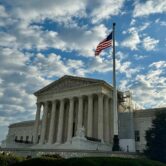MANHATTAN (CN) — Seeking another chance to try decades-old claims that a clothing brand copied its famed three-stripe logo, Adidas argued in front of the Second Circuit Wednesday that the Thom Browne clothing company was unfairly favored at trial.
A Manhattan federal jury returned a verdict in favor of Thom Browne at the end of an eight-day trial last year after Adidas claimed Thom Browne was confusing consumers by selling activewear with four stripes reminiscent of Adidas' iconic three-stripe shoes and athletic clothing. The two brands have been in dispute since 2007 when Adidas first objected to Thom Browne’s use of the stripes.
On Wednesday, Adidas argued that the jury was biased by a slew of jury instructions that favored Thom Browne.
Adidas attorney Charles Henn of Kilpatrick Townsend said U.S. District Judge Jed Rakoff was wrong to tell jurors to consider whether the two brands were competing in the same market because that legal framework didn't apply to Adidas’ claims.
“Adidas expressly said it was not asserting confusion at the point of sale. Instead, Adidas limited its theories of confusion to initial interest confusion and post-sale confusion,” Henn said. “Notwithstanding, the district judge instructed the jury on the proximity factor that the jury should determine whether the parties compete for the same consumers.”
U.S. Circuit Judge Barrington Parker Jr., a George W. Bush appointee, shot back that Judge Rakoff had already stressed Adidas’ claims to initial interest and post-sale confusion in his jury instructions.
“You had no right to have that instruction put to the jury. It’s not your charge, it’s the court’s charge,” Parker said. “And the court, it seems to me, at more than one occasion made exactly the point you’re claiming had not been made.”
Robert Thomas Maldonado of Wolf Greenfield, an attorney representing Thom Browne, acknowledged that the court instructed the jury to only consider the confusion claims made by Adidas, but said the concept of “competitive proximity” was in fact relevant to those claims.
“The court made it clear that this was a pre-sale and post-sale confusion case. The instruction on competitive proximity is not an instruction that’s limited to point-of-sale cases,” Maldonado said Wednesday. “Competitive proximity is relevant, even in post-sale cases.”
But Henn held that it was wrong for the jury instruction to focus on competition for the same market.
“In the context of post-sale confusion, the person who is confused is, in fact, not a consumer that Thom Browne is competing for. It’s a consumer that Adidas is competing for and sees a Thom Browne product and is confused by that,” Henn argued.
Adidas also claims that the court erred by excluding its expert witness William D’Arienzo, who was expected to testify that the “line between luxury brands and sportswear has blurred significantly in recent years.”
Thom Browne conversely argued that the court was right to exclude D’Arienzo’s testimony because his opinions were “not based on any reliable methodology.”
“The court ultimately did not permit him to testify because it was no longer an issue in the case," Maldonado said. "It was because the point was irrelevant.”
U.S. Circuit Judge Guido Calabresi, a Bill Clinton appointee, and U.S. Circuit Judge Michael H. Park, a Donald Trump appointee, were also on the panel.
Neither party’s attorney responded to a request for comment.
Subscribe to Closing Arguments
Sign up for new weekly newsletter Closing Arguments to get the latest about ongoing trials, major litigation and hot cases and rulings in courthouses around the U.S. and the world.









